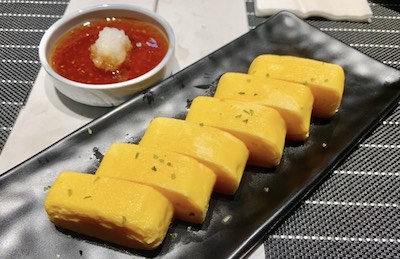We are reader supported. When you purchase through links on our site, we may earn an affiliate commission. Also, as an Amazon affiliate, we earn from qualifying purchases.
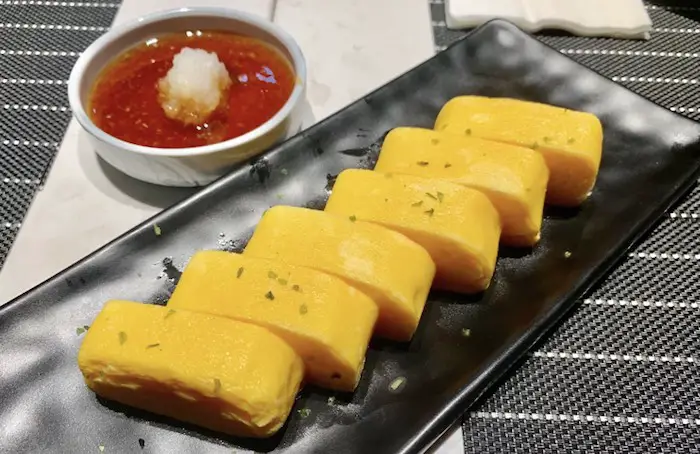
Sweet and savory, fluffy and bouncy…that’s Tamago (Tamagoyaki). If you are a non-Japanese, the name may sound intimidating to you at first. This is the Japanese term for a rolled omelet, served as an essential part of Japanese breakfast or put in bento boxes.
If you come to Tsukiji market in Tokyo on any fine day, you can see tourists queuing up to eat this traditional delicacy. It ranks as one of the top 30 foods you must try during your visit to Japan. It can be enjoyed as a sole delicacy or as a filling inside a sushi roll.
If you are craving for Tamago (Tamagoyaki), you don’t have to go to Japan to eat one. I will show you how you can make this delicious Japanese dish at home. But before that, I would like to tell you some interesting facts about Tamago.
Contents
What Is Tamagoyaki?
Tamagoyaki is made of two words – Tamago, which means egg and yaki, which means fry. However, don’t get mistaken to believe that this is a fried egg dish. Tamagoyaki is a thickly rolled egg omelet which includes eggs, vinegar, mirin, soy sauce, sugar, and even sake.
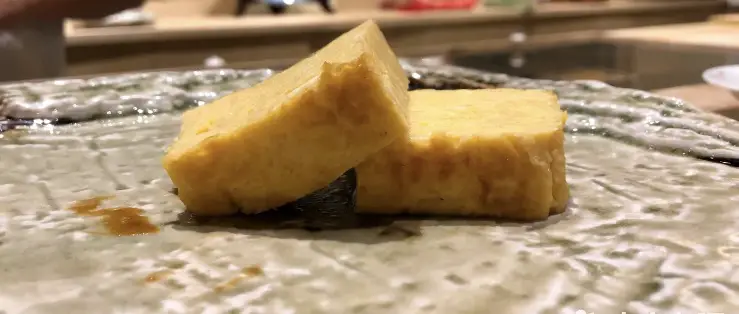
If you walk into a Japanese restaurant, Tamagoyaki, popularly referred to as Tamago, may not the most popular item on the menu. However, it holds a significant place in traditional Japanese cuisine. In the past, it was used as a means to judge a sushi chef’s skills.
Today, Tamago is a side dish or filling in sushi rolls that look like sliced up pieces of egg omelet layered one above the other. Earlier, it was used as a test of one’s ability, hence it was made from just a single layer and folded multiple times without breaking.
If the Tamago turned out broken or messy, the chef was considered as lacking in skills. Thus, the ability to come up with perfect tamago was regarded as a proud accomplishment. Some food connoisseurs may order a tamago sushi before starting their meal only to test the chef’s mettle.
3 Main Aspects Of A Good Tamagoyaki
The food experts usually rate a tamago according to taste, appearance, and texture. Here are the three main aspects of a good tamagoyaki.
Firm yet fluffy
This is perhaps the most crucial aspect of a tamago, which makes it difficult to make. The omelet should not be too hard or too mushy. An egg has the natural tendency to harden quickly when it comes in contact with a heated surface, hence the chef needs to control the temperature by moving the pan away from the flame.
Juicy and tender
As the egg mixture contains dashi, sugar and soy sauce, the cooked egg retains moisture. Thus, a good quality tomago must feel tender and have a lot of wetness.
Layered together
Tamagoyaki itself translates to egg rolled omelet so it is made of several layers of semi-cooked soft and juicy eggs that are wrapped together. You can see the layers from the side, with no air bubbles in between. Despite being without any bubbles trapped in between, they must have a bubbly texture.
Different Types Of Tamagoyaki (Japanese Rolled Omelet)
Interestingly, Tamagoyaki can be of two different types in Japanese cuisine – dashimaki tamago and atsuyaki tamago. Dashi-maki-tamago is the rolled egg omelet mixed with dashi (Japanese stock). Atsu-yaki-tamago is the thick fried egg without any additional seasonings. Both can be used as delectable ingredients in making sushi.
The Dashi-maki-tamago is typically used in making sushi dishes and I also prefer its taste due to the additional flavors of dashi (stock made of konbu seaweed). Dashi has such an important significance in Japanese cuisine that some restaurants have a chef whose main responsibility is to prepare dashi.
Let’s take a quick look at the difference between the two:
Atsuyaki Tamago Vs Dashi-Maki-Tamago
Flavors
Atsuyaki tamago is seasoned with sugar and soy sauce to enhance the taste of egg, however, dashi has its own unique flavor. The umami-rich katsuobushi and kombu added in Dashi-maki-tamago give it a distinct flavor without overpowering the taste of other ingredients.
Tamagoyaki itself has a nice taste. Adding the dashi stock to mixture helps in boosting the complex and rich flavors of the dish.
Texture
Atsuyaki Tamago comes out thicker as the liquid has a thicker consistency. When dashi is added to the liquid, it becomes thinner and more refined. As a result, Dashi-maki-tamago is juicier and softer due to the high liquid content.
In the sushi restaurants, they usually add dashi to the egg mixture to enhance the taste and add more softness to the roll. Although this results in difficulty in making, the overall taste is incredible.
Difficulty in cooking
This is perhaps the most important because unless you are able to give your tamago a good shape, it won’t turn out as intended. In case of Atsuyaki Tamago, the liquid is thin due to soy sauce and vinegar but comparatively thicker than dashimaki tamago. Thus, it’s still easy to roll for beginners.
When making dashimaki tamago, the egg mixture contains a lot of liquid seasonings and this makes the mixture watery. If you are new to making tamagoyaki sushi, I would recommend that you first start with using Atsuyaki Tamago as the filling.
When you achieve perfection at rolling Atsuyaki Tamago, you can take the next step and add dashi. In the beginning, add only a small amount of dashi and then keep on increasing slowly. For beginners, I usually recommend using about one tablespoon of dashi for each egg used.
Using The Right Frying Pan For Making Tamagoyaki
In some regions of Japan, such as the Kansai area, chefs use a special square or rectangle frying pan like this for making rolled egg omelet. The right pan plays an important role in maintaining the right cooking temperature to make a bouncy and fluffy tamagoyaki.
Some people may prefer using copper pans because they are a good conductor of heat. A copper pan not only heats up pretty quickly but the temperature also does not drop dramatically after adding egg mixture to it.
If you don’t have a rectangular pan, you may go ahead with a round pan of about 9 or 10-inch thickness. You may not get the classic shape of tamagoyaki but it will definitely get the work done. You get a flatter omelet if you have a bigger pan so a 12-inch round pan can help you get a better shape.
Talking about the material of frying pan used, you may use a pan made of cast iron skillet if you are not comfortable with non-stick. However, bear in mind that you will need to lift the pan to maintain the temperature and this can be tough with cast iron skillet.
You may also use a stainless steel pan but it will require a lot of oil. Hence, I recommend using a copper pan or non-stick pan that is much lighter.
Dashimaki Or Atsumaki Tamago Recipe
For Dashimaki Tamago:
• 3 eggs
• 1 tsp olive oil
• 2 tbsp water
• 2 tsp Shirodashi
For Atsumaki Tamago
• 3 eggs
• 1/2 tsp salt
• 2 tsp sugar
• 1 tsp olive oil
• 2 tbsp water
Instructions
Take a medium-size bowl and crack all the eggs into it. Now, add the above-mentioned seasonings to the bowl.
For dashimaki, add shirodashi (stock), olive oil, and water; and for making atsumaki tamago, add sugar, salt, olive oil, and water.
Mix all the ingredients together to form a consistent mix without forming too many bubbles. Now, strain the mixture through a sieve.
Put 2 tablespoon oil in a small bowl and put a kitchen paper inside to let it soak the oil completely. Keep this oil paper aside.
Place a frying pan on a gas stove and pour about a teaspoon of olive oil. Set the flame on medium heat and wait until you can see the oil heating up slightly.
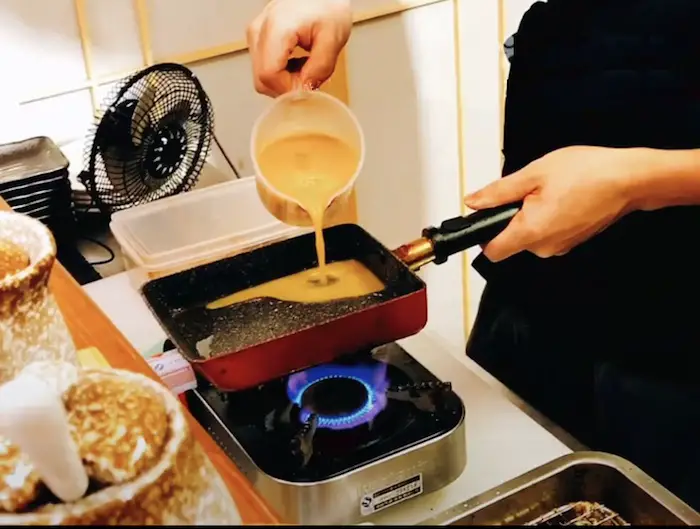
Pour about one-third of the egg mixture inside the pan (expect to hear a sizzling sound as you do). If any bubbles are formed, break them using a spoon.
As the egg layer solidifies a little, fold the egg until you reach the end of the omelet and push the folded egg to one end.
Wipe the pan with the oil paper we prepared earlier and now pour the next one-third of the egg mixture on the empty side.
Use chopsticks to lift the egg slightly and allow the egg mixture to run beneath it. Now, fold and roll the egg again to the other side of the pan and wipe the empty space with oil paper.
Now, pour the remaining part of the egg mixture and turn off the heat. Wrap the rolled egg omelet in a kitchen towel.
Wrap the tamagoyaki using a sushi mat to give a nice shape to it. Allow the rolled egg omelet to cool down. When it cools completely, cut the roll into 2cm thick slices and serve.
Pro Tips For Making Your Tamagoyaki Look Great
If you want your tamagoyaki to look moist, fluffy and yellow in color, cook on low to medium heat and use less amount of soy sauce. When you use less soy sauce, the omelet will turn out beautiful and light colored. This is an important tip if you want to prevent browning.
You may enhance the flavor by adding finely chopped garlic chives, green onions, or nori seaweed to the egg mixture. You may achieve a yellow-and-black spiral effect by adding torn pieces of nori over every egg layer before rolling.
If the tamagoyaki looks too runny, you can thicken the consistency by microwaving it for a minute. Remember to not overcook in the oven or you will end up with a rubbery texture. Serve tamagoyaki with soy sauce and grated daikon radish.
Adding A Nori Sheet To Enhance The Taste Of Tamago
Nori not only increases the flavor but also adds more nutrients to any dish, so here’s a twist to the tamagoyaki recipe. If you are a Nori fan or you just want the omelet to look and taste better, put a Nori sheet after the first layer of the omelet solidifies slightly.
When you cut the tamago containing a Nori sheet inside, it will give you a beautiful green line amidst all yellows. It looks pleasing to the eye and feels amazing to the tastebuds.
Learning The Art Of Making Tamago Sushi
Tamagoyaki tastes really good but when served as a dessert or snack, however, it is commonly used as a popular ingredient in maki rolls. Interestingly, tamago can be used for making different types of sushi. I must say that my friends who do not eat meat/ seafood but don’t mind eating eggs really love this recipe.
Tamago Nigiri Sushi (Recipe)
What you will need:
• Cooked sushi rice
• Vinegar
• Sugar
• Salt
• 1/2 nori sheet, cut into thin strips
• Pickled ginger
• Wasabi paste
To prepare this nigiri sushi, you will first need to cook and season sushi rice. You will find the detailed steps on how to cook rice perfectly and season with vinegar, sugar, and salt here.
Let the sushi rice sit while you prepare Dashimaki or Atsumaki tamagoyaki following the instructions given above.
Moisten your hands slightly and take a medium ball of rice, nearly 15 grams in weight and shape it into an oval bed
Put the bed of rice over the slice of Tamagoyaki and use two fingers to shape it correctly. Now, repeat to make more nigiri sushi like this.
Keep the omelet in place over the rice by fastening it with a strip of nori. Serve with wasabi and ginger.
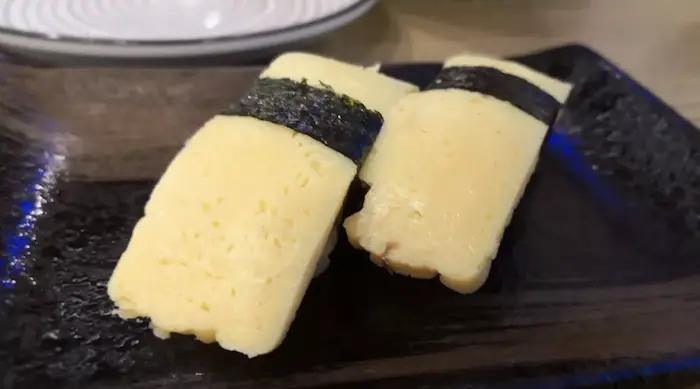
Maki Sushi With Tamagoyaki Recipe (Traditional Style)
What you will need:
• Cooked Sushi rice
• Vinegar
• Sugar
• Salt
• Nori sheets
• Tamagoyaki (rolled egg omelet)
• Spring onions
• Shrimp roe (optional)
Cook sushi rice in a cooker or pot to a perfect texture, let it cool and then season with vinegar, sugar, and salt. Find step-by-step instructions here.
Now prepare the fillings by cutting Tamagoyaki into thin strips. You must also finely chop spring onions and keep aside. Spring onions add freshness to the roll.
Now put a bamboo mat on the working surface and place a Nori sheet on it, rough side facing upwards

Take a medium ball of seasoned sushi rice and layer it over the Nori sheet evenly, pressing gently with your fingers
Now, arrange the Tamagoyaki strips over the sushi rice, place them towards you. Add finely chopped spring onions beside omelet strips and sprinkle some roe over it.
Now lift the bamboo mat from your side and start rolling, press gently to make a compact roll. When you reach the end, moisten the Nori sheet slightly and seal it.
Take a sharp Japanese knife, moisten the blade slightly and cut the roll into 6-8 equal halves.
California Tamago Sushi Roll (Inside- Out Style)
What you will need:
• Cooked sushi rice
• Vinegar
• Sugar
• Salt
• Nori sheet
• Tamago (rolled egg omelet)
• Imitation crab
• Japanese mayo
• Half cucumber
• Toasted sesame seeds
• Pickled ginger
• Soy sauce
First, you need to cook sushi rice, allow it to cool and season the rice well with vinegar, sugar, and salt. If you are a beginner, find all the information you need here.
Prepare rolled egg omelet using two eggs, mirin, 1 tbsp sugar, and some salt. Refer to the instructions provided above. Make thick strips of the tamago instead of cutting it into slices.
Also, prepare the fillings by slicing the cucumber into thin strips. Use a food processor to finely chop the imitation crab.
Put the bamboo mat on the kitchen table and wrap it with a plastic sheet to prevent rice from sticking on it.
Now, place a Nori sheet over the plastic wrap. Take a medium ball of rice and make an even layer on the Nori sheet
Sprinkle the toasted sesame seeds on the rice and flip it over. Arrange the tamago and cucumber strips first, covering the entire length of the Nori.
Now add the finely chopped imitation crabmeat beside the cucumber slice. Lift the bamboo mat from your side and start rolling to make a compact shape.
Remove the bamboo mat and give one tight hug to the roll. Take a sharp knife and cut the roll with the plastic sheet over it.
Take out the plastic wraps and serve with soy sauce, wasabi, and pickled ginger.
Useful Tips for Making Restaurant-like Tamagoyaki At Home
I cannot deny that making perfect Tamagoyaki certainly requires some skills and a good frying pan. You must also have patience and a presence of mind to roll it out like a dream. Here are some useful tips that can help you prepare this delicacy spot on!
Focus on finishing it well:
If you are a beginner, it is accepted that you may find it difficult to make the first few rolls neatly. Don’t panic if they don’t come out well because they will be inside the roll anyway. Focus on finishing it well and getting a perfect last layer that can cover all imperfections.
Never skip oiling the pan
Even if you are health conscious and wish to use less oil in your food, make sure you don’t skip this step. Oil the pan well before you start and rub the bottom with an oil-soaked kitchen paper before pouring each layer. This is important to ensure that the omelet does not stick to the surface.
Pour the egg mixture when the pan is well-heated
Don’t hurry into pouring the egg mixture when the pan is not hot enough. You may do a test by sprinkling some egg mixture to see if the pan sizzles. Adding mixture to a cold pan will not give you a perfect Japanese omelet.
Move pan away from the stove instead of turning off heat
Always keep the flame on medium heat and move the pan away instead of turning off the heat. You will need to adjust the heat to ensure that the omelet is cooked perfectly before you start rolling. The best way to control the temperature is to move the pan away from the stove.
Don’t roast the egg omelet too much
Start rolling as soon as the egg mixture solidifies slightly. Don’t wait for it to turn brown or get roasted or else it will be difficult to roll the omelet.
My Recommendations For Top 5 Tamagoyaki Frying Pans
#1. Iwachu Iron Tamagoyaki Omelette Pan, Black
This is a traditional cast-iron tamagoyaki frying pan in a rectangular shape for making Japanese rolled omelet. As it’s made of cast iron, the pan is highly durable and retains heat too. The wooden handle ensures that it stays cool for you to hold while rolling the egg.
The unique sloping design of the pan makes it easier for the mixture to spread as you pour. It offers you a unique blend of quality service, durability, and affordability. However, please remember that this pan will be slightly heavy so I would recommend it for professionals.
#2. Asahi Cne117 Egg Pan Tamagoyaki Professional Model
If you prefer copper pans, this model from the house of Asahi makes a good choice for professionals. As it is made of copper, the pan transmits heat evenly to cook egg faster. It does not stick to the surface and can cook four eggs at a time with ease.
The egg pan comes with a wooden lid and a handle to keep the egg flat and give it a nice shape. As this is a non-stick pan, you will be able to use it for various purposes. If you have basic skills in making tamago, you can advance your skills from there.
#3. MyLifeUNIT Non-Stick Omelette Pan
For those who prefer non-stick frying pans over others, check out this model made from a heavy-duty metal including manganese and aluminum alloy. It also features the impressive maifanite stone coating that gives it a great appearance.
The sloping design is perfect for flipping the omelet and the magnetic conductive base made of stainless steel helps in heating up faster. The handle is made of ABS material, which makes it fireproof. The pan works well in different bases such as gas stove, induction, and cookers.
#4. GreenPan Mini Ceramic Non-Stick Square Egg Pan
Those who are concerned about keeping the environment green can opt for the GreenPan ceramic non-stick pan on Amazon. It is safe cookware that does not contain any persistent pollutants or hazardous chemicals. It contains no cadmium, PFAs, PFOA, or cadmium.
The ceramic coating on the frying pan can serve you for several years without peeling off, blistering or giving off any harmful fumes. It also scores good marks in heat distribution so the omelet comes out uniformly cooked. You can also use this pan to make a burger or toast.
#5. TeChef – Tamagoyaki Japanese Omelette Pan
Do you have a square designed Tamagoyaki frying pan on your mind? I recommend this especially for the beginners as it is easy to handle and use. The body is constructed using aluminum while the base is made of stainless steel to promote enhanced heat conductivity and uniform heat distribution.
The non-stick pan comes with the latest Teflon DuPont coating and it is free of any Teflon and Perfluorooctanoic Acid (PFOA). The pan is safe, eco-friendly and FDA approved. The handle has a nice texture to give you a good grip and ample space makes it easier to roll and flip. Check the price on Amazon
Related Questions
Is tamago sushi safe for pregnant women?
Yes of course. The risk factor in easting sushi primarily comes from raw fish that may contain bacteria. Tamago is made of eggs that are cooked in the style of an omelet, hence it’s absolutely safe for pregnant women.
What does tamagoyaki taste like?
Tamago features a sweet and delicate taste which is almost like egg custard, however, it’s not too sweet to make you want a palate cleanser afterward. It is common for the Japanese to save tamago for the end of their meal. It actually forms a bridge between the sweet and savory courses. In some restaurants, they are often served as a dessert at the end.
How long can tamago last in the refrigerator
If stored inside a refrigerator, a tamago can last for about a week. However, it tastes best when served fresh. You may make it anytime for breakfast, snack or dessert.
Can I alter the recipe?
You may alter the recipe by adjusting the salt and sugar amount depending on whether you want it to be more sweet or savory. If you are a beginner and rolling looks difficult, consider making sheets of cooked eggs, put them into layers and slice in the shape of a rectangle. It ensures less wastage and gives you a neat cut.
What can you add in egg mixture to make it colorful
You can enhance the appearance and taste of your humble tamago by adding different vegetables such as finely chopped carrots, green onions, and thin shreds of nori. Some people also like adding finely chopped mushrooms to enhance the taste.

